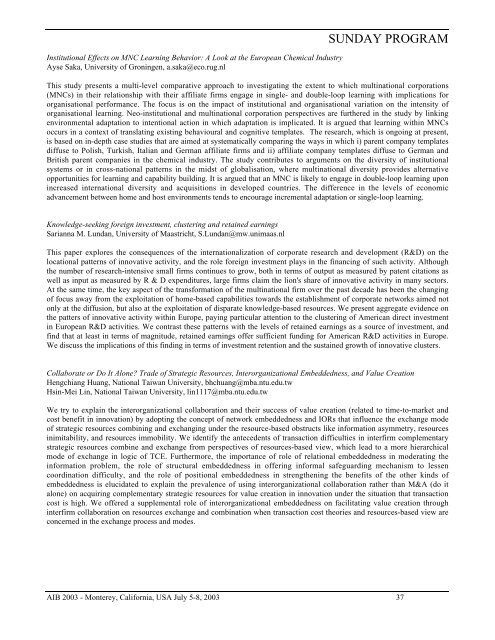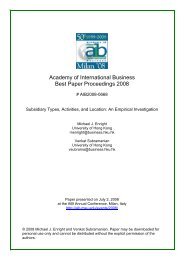Institutional Effects on MNC Learning Behavior: A Look at the European Chemical IndustryAyse Saka, University <strong>of</strong> Groningen, a.saka@eco.rug.nlSUNDAY PROGRAMThis study presents a multi-level comparative approach to investigating the extent to which multinational corporations(MNCs) in their relationship with their affiliate firms engage in single- and double-loop learning with implications fororganisational performance. The focus is on the impact <strong>of</strong> institutional and organisational variation on the intensity <strong>of</strong>organisational learning. Neo-institutional and multinational corporation perspectives are furthered in the study by linkingenvironmental adaptation to intentional action in which adaptation is implicated. It is argued that learning within MNCsoccurs in a context <strong>of</strong> translating existing behavioural and cognitive templates. The research, which is ongoing at present,is based on in-depth case studies that are aimed at systematically comparing the ways in which i) parent company templatesdiffuse to Polish, Turkish, Italian and German affiliate firms and ii) affiliate company templates diffuse to German andBritish parent companies in the chemical industry. The study contributes to arguments on the diversity <strong>of</strong> institutionalsystems or in cross-national patterns in the midst <strong>of</strong> globalisation, where multinational diversity provides alternativeopportunities for learning and capability building. It is argued that an MNC is likely to engage in double-loop learning uponincreased international diversity and acquisitions in developed countries. The difference in the levels <strong>of</strong> economicadvancement between home and host environments tends to encourage incremental adaptation or single-loop learning.Knowledge-seeking foreign investment, clustering and retained earningsSarianna M. Lundan, University <strong>of</strong> Maastricht, S.Lundan@mw.unimaas.nlThis paper explores the consequences <strong>of</strong> the internationalization <strong>of</strong> corporate research and development (R&D) on thelocational patterns <strong>of</strong> innovative activity, and the role foreign investment plays in the financing <strong>of</strong> such activity. Althoughthe number <strong>of</strong> research-intensive small firms continues to grow, both in terms <strong>of</strong> output as measured by patent citations aswell as input as measured by R & D expenditures, large firms claim the lion's share <strong>of</strong> innovative activity in many sectors.At the same time, the key aspect <strong>of</strong> the transformation <strong>of</strong> the multinational firm over the past decade has been the changing<strong>of</strong> focus away from the exploitation <strong>of</strong> home-based capabilities towards the establishment <strong>of</strong> corporate networks aimed notonly at the diffusion, but also at the exploitation <strong>of</strong> disparate knowledge-based resources. We present aggregate evidence onthe patters <strong>of</strong> innovative activity within Europe, paying particular attention to the clustering <strong>of</strong> American direct investmentin European R&D activities. We contrast these patterns with the levels <strong>of</strong> retained earnings as a source <strong>of</strong> investment, andfind that at least in terms <strong>of</strong> magnitude, retained earnings <strong>of</strong>fer sufficient funding for American R&D activities in Europe.We discuss the implications <strong>of</strong> this finding in terms <strong>of</strong> investment retention and the sustained growth <strong>of</strong> innovative clusters.Collaborate or Do It Alone? Trade <strong>of</strong> Strategic Resources, Interorganizational Embeddedness, and Value CreationHengchiang Huang, National Taiwan University, bhchuang@mba.ntu.edu.twHsin-Mei Lin, National Taiwan University, lin1117@mba.ntu.edu.twWe try to explain the interorganizational collaboration and their success <strong>of</strong> value creation (related to time-to-market andcost benefit in innovation) by adopting the concept <strong>of</strong> network embeddedness and IORs that influence the exchange mode<strong>of</strong> strategic resources combining and exchanging under the resource-based obstructs like information asymmetry, resourcesinimitability, and resources immobility. We identify the antecedents <strong>of</strong> transaction difficulties in interfirm complementarystrategic resources combine and exchange from perspectives <strong>of</strong> resources-based view, which lead to a more hierarchicalmode <strong>of</strong> exchange in logic <strong>of</strong> TCE. Furthermore, the importance <strong>of</strong> role <strong>of</strong> relational embeddedness in moderating theinformation problem, the role <strong>of</strong> structural embeddedness in <strong>of</strong>fering informal safeguarding mechanism to lessencoordination difficulty, and the role <strong>of</strong> positional embeddedness in strengthening the benefits <strong>of</strong> the other kinds <strong>of</strong>embeddedness is elucidated to explain the prevalence <strong>of</strong> using interorganizational collaboration rather than M&A (do italone) on acquiring complementary strategic resources for value creation in innovation under the situation that transactioncost is high. We <strong>of</strong>fered a supplemental role <strong>of</strong> interorganizational embeddedness on facilitating value creation throughinterfirm collaboration on resources exchange and combination when transaction cost theories and resources-based view areconcerned in the exchange process and modes.AIB 2003 - Monterey, California, USA July 5-8, 2003 37
Session 1.2.7 - Track 1 - PANELSUNDAY PROGRAMTCE: The Next Generation - The Enduring Influence <strong>of</strong> Williamson’s Transaction Cost EconomicsTheory on <strong>International</strong> <strong>Business</strong> ResearchRoom: Windjammer 1-2Time: 3:30-5:00 p.m.Chair: Brian Silverman, University <strong>of</strong> Toronto, Silverman@Rotman.Utoronto.CaDiscussant: Oliver E. Williamson, University <strong>of</strong> California Berkeley, owilliam@haas.berkeley.eduFor more than 25 years, transaction cost economics has had an immense impact on international business research. Thispanel explores the enduring influence <strong>of</strong> transaction cost economics within international business scholarship, particularlyrelated to foreign direct investment decisions, alliance formation and governance, and the influence <strong>of</strong> political institutionson multinationals’ location and organization decisions. The panel includes studies that both survey recent refinements inthe application <strong>of</strong> transaction cost economics to IB, and invoke and elaborate transaction cost reasoning to provide newinsight to longstanding challenges in the international business field.The Prevalence <strong>of</strong> Transaction Cost Logic in Current IB ResearchJeffrey T. Macher, Georgetown University, Jtm4@georgetown.eduGovernance and Competence Perspectives on <strong>International</strong> Alliances: Family Feud or Happy Marriage?Joanne E. Oxley, University <strong>of</strong> <strong>Michigan</strong>, oxley@umich.eduExplicating Political HazardsWitold J. Henisz, University <strong>of</strong> Pennsylvania, henisz@wharton.upenn.eduBennet Zelner, Georgetown University, zelnerb@georgetown.eduEfficient Organization and Endogeneity Issues in Foreign Direct Investment ResearchJ. Myles Shaver, University <strong>of</strong> Minnesota, James054@umn.eduSession 1.2.8 - Track 8 - COMPETITIVEFinancial Perspectives on Multinational EnterpriseRoom: Windjammer 3-4Time: 3:30-5:00 p.m.Chair: Bernard Yeung, New York University, byeung@stern.nyu.eduDiscussant: David Reeb, University <strong>of</strong> Alabama, dreeb@cba.ua.eduA Multinational Perspective on Capital Structure and Internal Capital MarketsMihir Desai, Harvard <strong>Business</strong> School, mdesai@hbs.eduHow do firms alter their financing choices in response to tax incentives and the quality <strong>of</strong> the contracting environment inwhich they operate? This paper employs detailed data on how U.S. multinationals finance foreign affiliates to isolate therole <strong>of</strong> tax incentives and legal regimes on capital structure and the workings <strong>of</strong> internal capital markets withinmultinational firms. First, the paper identifies significant tax effects for capital structure choice by examining howmultinationals respond to distinct tax incentives around the world. Second, by examining the interest costs faced bymultinationals around the world, the paper isolates how weak creditor rights and underdeveloped capital markets translateinto higher costs <strong>of</strong> external finance and how firms respond to these higher costs by changing the level and composition <strong>of</strong>their borrowing decisions. Third, the papers identifies a significant substitutability between internal borrowing and externalborrowing for multinational firms suggesting that multinational firms rely on opportunities not available to local firms.Multinational firms appear to capitalize significantly on tax advantages and global borrowing capacity in their worldwideoperations.AIB 2003 - Monterey, California, USA July 5-8, 2003 38
- Page 1 and 2: AIB2 0 0 3The Power of Ideas and In
- Page 3 and 4: The 45th Annual Meetingof the Acade
- Page 5 and 6: AIB 2003 - Monterey, California, US
- Page 7 and 8: SATURDAYSATURDAY - 8:30 a.m.- 4:00
- Page 9 and 10: MONDAY - 10:00-10:30 a.m.Coffee Bre
- Page 11 and 12: 3.8 - TUESDAY - 1:30-3:00 p.m.Sessi
- Page 13 and 14: AIB 2003 - Monterey, California, US
- Page 15 and 16: SUNDAY - July 6, 2003SUNDAY PROGRAM
- Page 17 and 18: SUNDAY PROGRAMUsing Political and E
- Page 19 and 20: Host country product diversity and
- Page 21 and 22: Time will Tell? Socialisation towar
- Page 23 and 24: SUNDAY PROGRAMNational Competitiven
- Page 25 and 26: Strategies for Closed Markets: Camp
- Page 27 and 28: SUNDAY PROGRAMChinese Foreign Direc
- Page 29 and 30: SUNDAY PROGRAMThe Impact of Copyrig
- Page 31 and 32: SUNDAY PROGRAMSession 1.2.1 BALASMa
- Page 33 and 34: SUNDAY PROGRAMThe Effect of Nationa
- Page 35 and 36: SUNDAY PROGRAMSession 1.2.4 - Track
- Page 37: The Determinants of Competitive Adv
- Page 41 and 42: MONDAY - July 7, 2003MONDAY PROGRAM
- Page 43 and 44: MONDAY PROGRAMSession 2.3.3 - Track
- Page 45 and 46: MONDAY PROGRAMInter-firm linkages a
- Page 47 and 48: Session 2.3.6 - Track 6 - COMPETITI
- Page 49 and 50: The Decision to Privatize as the Di
- Page 51 and 52: MONDAY PROGRAMPrivatization in Indi
- Page 53 and 54: MONDAY PROGRAMAn Integration-Based
- Page 55 and 56: MONDAY PROGRAMSession 2.4.4 - Track
- Page 57 and 58: Session 2.4.6 - Track 6 - WORKSHOPB
- Page 59 and 60: MONDAY PROGRAMSession 2.4.8 - Track
- Page 61 and 62: MONDAY PROGRAMCultural distance and
- Page 63 and 64: Too much similarity causes differen
- Page 65 and 66: MONDAY PROGRAMThe Impact of Firm Pe
- Page 67 and 68: MONDAY PROGRAMBusiness Associations
- Page 69 and 70: MONDAY PROGRAMInternational Marketi
- Page 71 and 72: MONDAY PROGRAMThe Taxation of Indus
- Page 73 and 74: MONDAY PROGRAMSession 2.5.3 - Track
- Page 75 and 76: Explaining Subsidiary Network Embed
- Page 77 and 78: Top Managers’ Influence on Innova
- Page 79 and 80: MONDAY PROGRAMSession 2.5.8 - Track
- Page 81 and 82: TUESDAY PROGRAMvariable that seems
- Page 83 and 84: TUESDAY PROGRAMHow Corruption Affec
- Page 85 and 86: TUESDAY PROGRAMH-shares as well as
- Page 87 and 88: TUESDAY PROGRAMCooperative Strategi
- Page 89 and 90:
Political Connectedness and the For
- Page 91 and 92:
TUESDAY PROGRAMSession 3.7.3 - Trac
- Page 93 and 94:
TUESDAY PROGRAMmovers to neutralise
- Page 95 and 96:
TUESDAY PROGRAMSession 3.7.6 - Trac
- Page 97 and 98:
TUESDAY PROGRAMthey plan strategica
- Page 99 and 100:
TUESDAY PROGRAMSession 3.8.1 - Trac
- Page 101 and 102:
TUESDAY PROGRAMmodel among the four
- Page 103 and 104:
TUESDAY PROGRAMextent to which MNEs
- Page 105 and 106:
TUESDAY PROGRAMSession 3.8.6 - Trac
- Page 107 and 108:
TUESDAY PROGRAMSession 3.8.8 - Trac
- Page 109 and 110:
Strategic Modularization, Evolution
- Page 111 and 112:
TUESDAY PROGRAMHow Corporate Govern
- Page 113 and 114:
Imitating and Learning from Others:
- Page 115 and 116:
TUESDAY PROGRAMSession 3.9.8 - Trac
- Page 117 and 118:
TUESDAY PROGRAMWal-Mart Vs. Carrefo
- Page 119 and 120:
TUESDAY PROGRAMthe b-entity, is dev
- Page 121 and 122:
TUESDAY PROGRAMThe Expatriate Exper
- Page 123 and 124:
Track 9 - Finance, Accounting, and
- Page 125 and 126:
List of ParticipantsAdler, Nancy J.
- Page 127 and 128:
Pangarkar, Nitin 1.1.1, 2.3.1, 3.8.
















